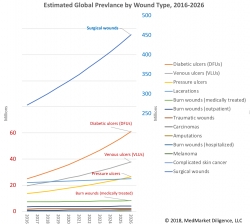Billions in Global Wound Product Sales, Yet Chronic Wounds Remain a Chronic Problem, Based on New Research from MedMarket Diligence
Despite the legion of products developed for wound care, from dressings to negative pressure wound therapy to bioengineered skin and growth factors, the obesity- and age-driven increase in chronic slow-healing and non-healing wounds plague healthcare systems globally. Research and routine clinical practice have advanced the science to better understand and address chronic wounds, but much work remains for research and manufacturing to impact the growing caseload.

Biddeford, ME, April 10, 2018 --(PR.com)-- Chronic wounds represent a large but still underestimated problem for health systems globally and industry needs to step up in response, according to MedMarket Diligence, LLC.
"Our recent research shows that chronic wounds, which have long been no secret to clinicians, epidemiologists, and product manufacturers as a growing health problem, are actually even more prevalent and costly than has been previously reported," says Patrick Driscoll of MedMarket Diligence, who has tracked wounds in clinical practice and industry for 25 years.
Care of chronic wounds is a significant, global burden on healthcare systems. In the USA alone, it is estimated that at least 6.7 million people suffer with chronic wounds, requiring treatment in excess of $20-50 billion per year (estimates vary according to the definitions). A report from the UK suggests, based on National Health System (NHS) data, that chronic wound prevalence in developed countries is about 6% and that care of chronic wounds accounts for around 3-5.5% of total healthcare spending in those countries. (Phillips CJ, et al. Estimating the costs associated with the management of patients with chronic wounds using linked routine data. Int Wound J. 2015. doi: 10.1111/iwj.12443.)
Definitions help clinicians determine whether a wound is healing or not. For example, for venous leg ulcers (VLUs), if the wound has not shown at least a 40% reduction in wound size in about four weeks, then additional therapies are called for. A non-healing foot ulcer is generally defined to be any ulcer that is unresponsive to standard therapies and persists after four weeks of standard care. Once a foot ulcer occurs, unfortunately some 60% of patients end up moving into the chronic non-healing category. Many diabetics develop foot ulcers.
Chronic wounds and burns continue to present challenging clinical problems. For example, chronic wounds may present with persistent infections, inflammation, hypoxia, non-responsive cells at the wound edge, the need for regular debridement, etc. For DFUs, it is important for the patient to continuously wear an offloading device such as a special boot. Additionally, the practitioner must carefully debride not only the necrotic tissue in the wound bed, but the wound edges. Cells at the wound edge seem to be unresponsive to typical healing signals, and therefore must be removed to promote and support proper healing.
Wound management is the subject ongoing research and publications by MedMarket Diligence, LLC; https://mediligence.com/s254/.
"Our recent research shows that chronic wounds, which have long been no secret to clinicians, epidemiologists, and product manufacturers as a growing health problem, are actually even more prevalent and costly than has been previously reported," says Patrick Driscoll of MedMarket Diligence, who has tracked wounds in clinical practice and industry for 25 years.
Care of chronic wounds is a significant, global burden on healthcare systems. In the USA alone, it is estimated that at least 6.7 million people suffer with chronic wounds, requiring treatment in excess of $20-50 billion per year (estimates vary according to the definitions). A report from the UK suggests, based on National Health System (NHS) data, that chronic wound prevalence in developed countries is about 6% and that care of chronic wounds accounts for around 3-5.5% of total healthcare spending in those countries. (Phillips CJ, et al. Estimating the costs associated with the management of patients with chronic wounds using linked routine data. Int Wound J. 2015. doi: 10.1111/iwj.12443.)
Definitions help clinicians determine whether a wound is healing or not. For example, for venous leg ulcers (VLUs), if the wound has not shown at least a 40% reduction in wound size in about four weeks, then additional therapies are called for. A non-healing foot ulcer is generally defined to be any ulcer that is unresponsive to standard therapies and persists after four weeks of standard care. Once a foot ulcer occurs, unfortunately some 60% of patients end up moving into the chronic non-healing category. Many diabetics develop foot ulcers.
Chronic wounds and burns continue to present challenging clinical problems. For example, chronic wounds may present with persistent infections, inflammation, hypoxia, non-responsive cells at the wound edge, the need for regular debridement, etc. For DFUs, it is important for the patient to continuously wear an offloading device such as a special boot. Additionally, the practitioner must carefully debride not only the necrotic tissue in the wound bed, but the wound edges. Cells at the wound edge seem to be unresponsive to typical healing signals, and therefore must be removed to promote and support proper healing.
Wound management is the subject ongoing research and publications by MedMarket Diligence, LLC; https://mediligence.com/s254/.
Contact
MedMarket Diligence, LLC
Patrick Driscoll
207-613-6701
www.mediligence.com
Patrick Driscoll
207-613-6701
www.mediligence.com
Categories
